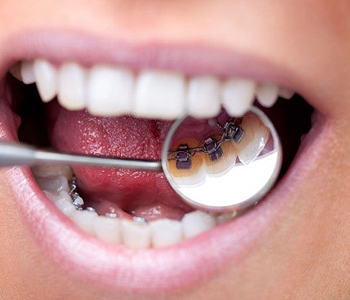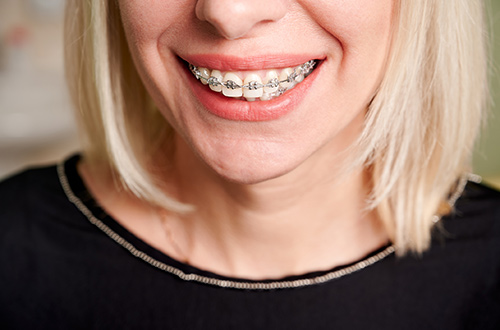Navigation
Top 10 orthodontic myths busted
There are several myths around braces, including who can have them and how they affect your day-to-day life. With so many advances in orthodontics, it’s not surprising there are some misconceptions about braces today. Here are some common orthodontic myths and the truth behind them:
![]()
1. Braces will affect my speech in the long-term
When you first have your braces fitted, it can take time to adjust to them, and some people find their speech is slightly affected. This is more common with lingual braces than traditional braces because they’re attached to the inner surface of your teeth. But in most cases, any speech changes are resolved within a few days, or at most within two months.
Braces can actually improve your speech long-term, as crooked or misaligned teeth can cause speech impediments.
![]()
2. I had braces as a teen so I can’t have them again
It’s possible to have braces more than once. If you didn’t wear your retainer and your teeth have shifted, you can have secondary treatment to realign your smile – it’s actually very common. You’ll need a consultation with your orthodontist to check your suitability and they’ll advise on next steps.
3. Braces are very noticeable
When people think of braces, they often think of visible metal ones. There are actually a wide range of clear or near-invisible braces, allowing you to straighten your teeth discreetly. These include:
- Clear ceramic braces: A type of fixed brace which uses clear brackets and tooth-coloured wires
- Invisalign treatment: A removable orthodontic system which uses clear, removable aligners
- Lingual braces: A type of fixed brace attached behind the teeth.
4. I can’t play sports if I have braces
As long as you keep your smile protected, having braces doesn’t prevent you from playing sports. If you have fixed braces, you can wear a custom-made gumshield designed to fit over them.
This will ensure your braces don’t get damaged, especially in contact sports. If you have removable braces, you can take them out for short periods, such as while you play, and replace them with a gumshield.
![]()
5. After braces, my teeth will stay straight
Your smile won’t stay straight after braces naturally - you’ll need to wear a retainer. When your braces are removed, your jaw, tissues and the roots of your teeth are still adjusting to the new position of your smile, so they aren’t yet ‘anchoring’ them in place. To prevent your teeth shifting, your orthodontist will provide you with a retainer.
![]()
6. Braces take years to work
Everyone’s journey is different. It may take one or two years to have your teeth straightened, but some people only need to straighten their front teeth in as little as six months1. Once your orthodontist has assessed your teeth, they’ll be able to give you a treatment plan which is designed to your individual needs.
7. Braces are only for younger people
One of the most common misconceptions about braces is that they’re only for teenagers. In reality, people of all ages wear braces. As long as your teeth and gums are healthy and you have enough healthy jawbone tissue, you should be able to have your teeth straightened.
To find out if you’re suitable, you’ll need to book a consultation with your local orthodontist.
8. I can’t eat the foods I like with braces
If you have removable braces, such as Invisalign aligners, you can take them out to eat and drink.
If you have fixed braces, you can still enjoy most foods, but you’ll need to be careful not to damage the wires. If you’re planning to eat crunchy foods such as apples, it’s best to cut them into smaller pieces. Try to stay clear of sticky foods altogether, such as caramel and chewy sweets, as they can loosen or break braces.
![]()
9. Orthodontics is only for people with very crooked teeth
Braces can correct a variety of concerns, from mild crowding, to gaps between teeth, overbites and underbites. A range of braces are available to treat different cases and your orthodontist will advise the best options for you.
![]()
10. Braces are very painful
Although it’s true that you can’t achieve a straighter smile without some level of discomfort, braces shouldn’t be very painful. If you have fixed braces, it may take a while to adjust to them. Your teeth and gums may feel sore in the first week, and each time you have your braces adjusted.
If you have removable aligners, you may find your teeth ache and are temporarily more sensitive when you first start treatment and when you change your aligners.
If you do experience discomfort, there are things you can do to manage this, such as taking over-the-counter painkillers and using orthodontic wax on parts of your brace that rub.
What to expect
At your consultation, we will chat through your options and suitability for different teeth straightening treatments.
*Terms and conditions:
1. Free consultations are to discuss options and suitability for treatment. You may require a more in-depth clinical examination or diagnostic tests before treatment options can be discussed. There may be a charge for such examination or test, payable by you. The clinician will discuss this with you before any such examination or test takes place, which may be done during the same appointment as your free consultation.
2. Consultations subject to availability.
3. Free consultations available at participating practices only.
We recognise that when you give us personal information (which includes health information) you’re trusting us to take good care of it. Please see www.bupa.co.uk/privacy for more information about how we collect, use and protect your data.
If you don’t want to receive marketing about Bupa products and services that we think are relevant to you, please contact us at [email protected].



